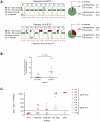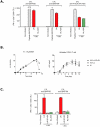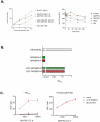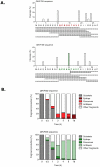CTL escape mediated by proteasomal destruction of an HIV-1 cryptic epitope
- PMID: 21589903
- PMCID: PMC3093368
- DOI: 10.1371/journal.ppat.1002049
CTL escape mediated by proteasomal destruction of an HIV-1 cryptic epitope
Abstract
Cytotoxic CD8+ T cells (CTLs) play a critical role in controlling viral infections. HIV-infected individuals develop CTL responses against epitopes derived from viral proteins, but also against cryptic epitopes encoded by viral alternative reading frames (ARF). We studied here the mechanisms of HIV-1 escape from CTLs targeting one such cryptic epitope, Q9VF, encoded by an HIVgag ARF and presented by HLA-B*07. Using PBMCs of HIV-infected patients, we first cloned and sequenced proviral DNA encoding for Q9VF. We identified several polymorphisms with a minority of proviruses encoding at position 5 an aspartic acid (Q9VF/5D) and a majority encoding an asparagine (Q9VF/5N). We compared the prevalence of each variant in PBMCs of HLA-B*07+ and HLA-B*07- patients. Proviruses encoding Q9VF/5D were significantly less represented in HLA-B*07+ than in HLA-B*07- patients, suggesting that Q9FV/5D encoding viruses might be under selective pressure in HLA-B*07+ individuals. We thus analyzed ex vivo CTL responses directed against Q9VF/5D and Q9VF/5N. Around 16% of HLA-B*07+ patients exhibited CTL responses targeting Q9VF epitopes. The frequency and the magnitude of CTL responses induced with Q9VF/5D or Q9VF/5N peptides were almost equal indicating a possible cross-reactivity of the same CTLs on the two peptides. We then dissected the cellular mechanisms involved in the presentation of Q9VF variants. As expected, cells infected with HIV strains encoding for Q9VF/5D were recognized by Q9VF/5D-specific CTLs. In contrast, Q9VF/5N-encoding strains were neither recognized by Q9VF/5N- nor by Q9VF/5D-specific CTLs. Using in vitro proteasomal digestions and MS/MS analysis, we demonstrate that the 5N variation introduces a strong proteasomal cleavage site within the epitope, leading to a dramatic reduction of Q9VF epitope production. Our results strongly suggest that HIV-1 escapes CTL surveillance by introducing mutations leading to HIV ARF-epitope destruction by proteasomes.
Conflict of interest statement
The authors have declared that no competing interests exist.
Figures




Similar articles
-
Clinical Control of HIV-1 by Cytotoxic T Cells Specific for Multiple Conserved Epitopes.J Virol. 2015 May;89(10):5330-9. doi: 10.1128/JVI.00020-15. Epub 2015 Mar 4. J Virol. 2015. PMID: 25741000 Free PMC article.
-
The antiviral efficacy of HIV-specific CD8⁺ T-cells to a conserved epitope is heavily dependent on the infecting HIV-1 isolate.PLoS Pathog. 2011 May;7(5):e1001341. doi: 10.1371/journal.ppat.1001341. Epub 2011 May 12. PLoS Pathog. 2011. PMID: 21589893 Free PMC article.
-
Impaired processing and presentation of cytotoxic-T-lymphocyte (CTL) epitopes are major escape mechanisms from CTL immune pressure in human immunodeficiency virus type 1 infection.J Virol. 2004 Feb;78(3):1324-32. doi: 10.1128/jvi.78.3.1324-1332.2004. J Virol. 2004. PMID: 14722287 Free PMC article.
-
The influence of HLA/HIV genetics on the occurrence of elite controllers and a need for therapeutics geotargeting view.Braz J Infect Dis. 2021 Sep-Oct;25(5):101619. doi: 10.1016/j.bjid.2021.101619. Epub 2021 Sep 22. Braz J Infect Dis. 2021. PMID: 34562387 Free PMC article. Review.
-
HLA-C and HIV-1: friends or foes?Retrovirology. 2012 May 9;9:39. doi: 10.1186/1742-4690-9-39. Retrovirology. 2012. PMID: 22571741 Free PMC article. Review.
Cited by
-
SARS-CoV-2 Consensus-Sequence and Matching Overlapping Peptides Design for COVID19 Immune Studies and Vaccine Development.Vaccines (Basel). 2020 Aug 6;8(3):444. doi: 10.3390/vaccines8030444. Vaccines (Basel). 2020. PMID: 32781672 Free PMC article.
-
Acute phase CD8+ T lymphocytes against alternate reading frame epitopes select for rapid viral escape during SIV infection.PLoS One. 2013 May 6;8(5):e61383. doi: 10.1371/journal.pone.0061383. Print 2013. PLoS One. 2013. PMID: 23671565 Free PMC article.
-
Antisense-Derived HIV-1 Cryptic Epitopes Are Not Major Drivers of Viral Evolution during the Acute Phase of Infection.J Virol. 2018 Sep 12;92(19):e00711-18. doi: 10.1128/JVI.00711-18. Print 2018 Oct 1. J Virol. 2018. PMID: 30021907 Free PMC article.
-
Defective HIV-1 genomes and their potential impact on HIV pathogenesis.Retrovirology. 2022 Jun 28;19(1):13. doi: 10.1186/s12977-022-00601-8. Retrovirology. 2022. PMID: 35764966 Free PMC article. Review.
-
Potential elucidation of a novel CTL epitope in HIV-1 protease by the protease inhibitor resistance mutation L90M.PLoS One. 2013 Aug 28;8(8):e71888. doi: 10.1371/journal.pone.0071888. eCollection 2013. PLoS One. 2013. PMID: 24015196 Free PMC article.
References
-
- Kiepiela P, Leslie AJ, Honeyborne I, Ramduth D, Thobakgale C, et al. Dominant influence of HLA-B in mediating the potential co-evolution of HIV and HLA. Nature. 2004;432:769–775. - PubMed
-
- Kiepiela P, Ngumbela K, Thobakgale C, Ramduth D, Honeyborne I, et al. CD8+ T-cell responses to different HIV proteins have discordant associations with viral load. Nat Med. 2007;13:46–53. - PubMed
Publication types
MeSH terms
Substances
LinkOut - more resources
Full Text Sources
Research Materials

